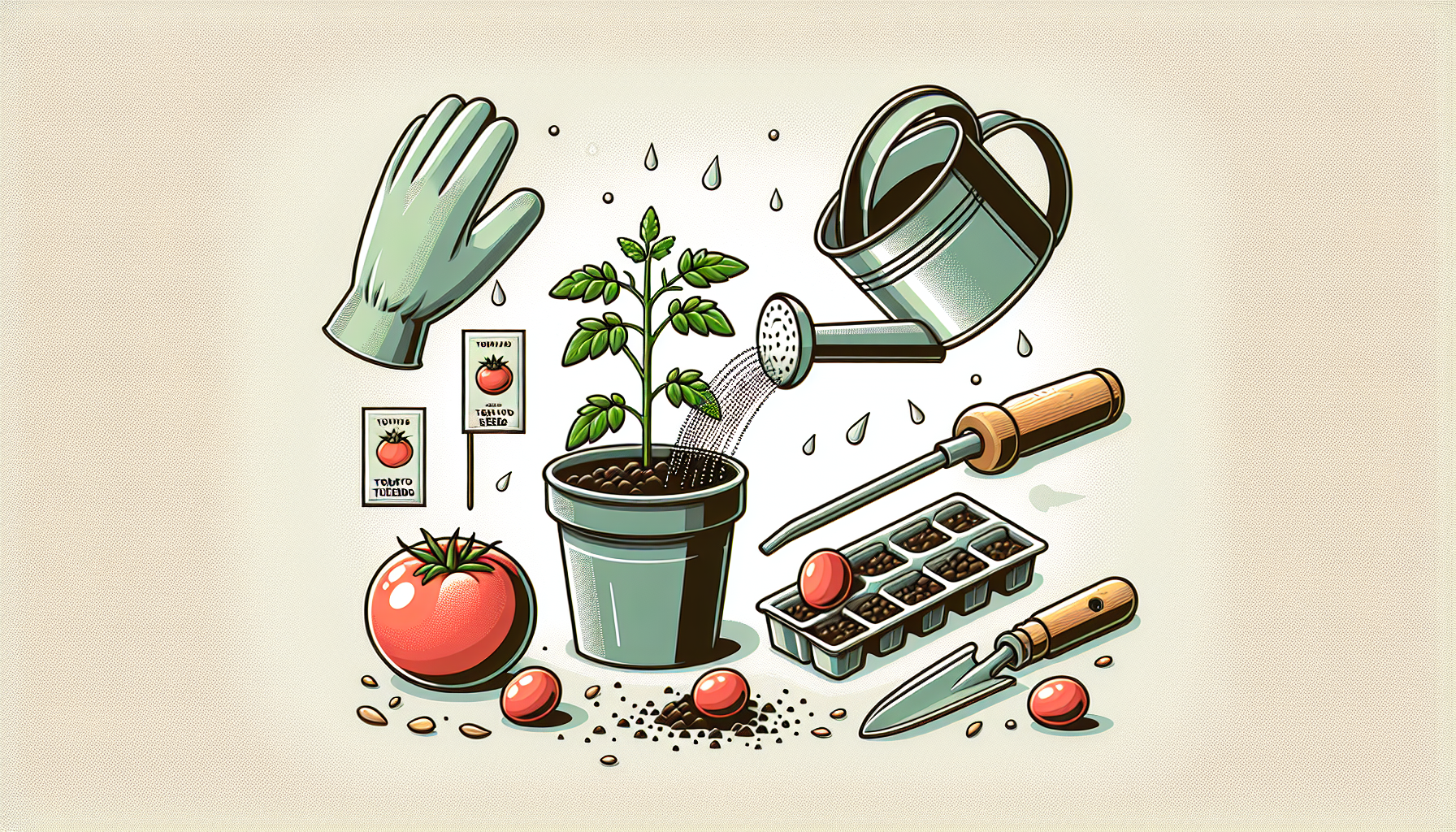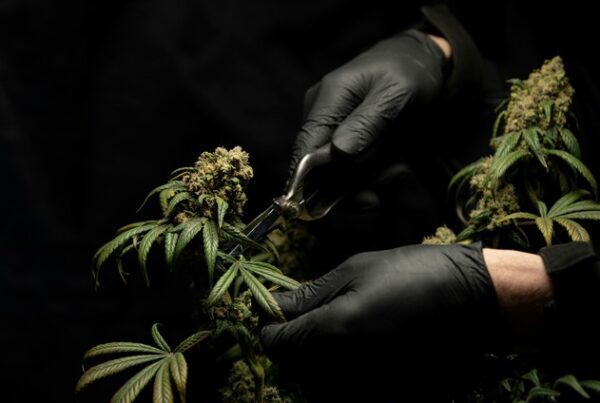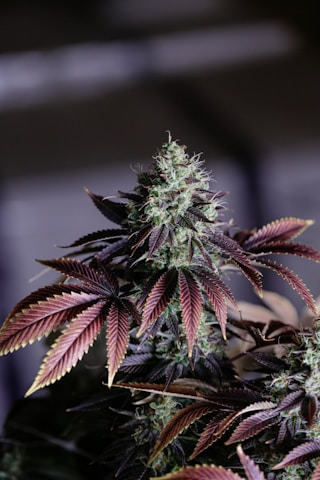Introduction

Growing tomatoes from seed allows gardeners to access a wider variety of tomato types, develop a deeper understanding of the plant’s life cycle, and achieve increased control over the cultivation process. High-quality tomato seeds contribute to healthier plants, better yields, and more flavorful fruits. This comprehensive guide offers valuable information and actionable steps for successfully growing tomatoes from seed, covering topics such as seed selection, planting techniques, and expert tips for maximizing growth and yield.
Types of Tomato Seeds
There are various types of tomato seeds available for gardeners to choose from. Each type has its unique characteristics, and understanding these differences can help you select the best seeds for your garden. In this section, we will discuss heirloom, hybrid, cherry, and beefsteak tomato seeds, as well as provide guidance on determining the best seeds for your garden.
Heirloom Tomato Seeds
Heirloom tomatoes are cherished for their unique flavors, colors, and shapes. These seeds are open-pollinated, meaning they are pollinated naturally, and the resulting plants will produce seeds that can be saved and planted to produce the same variety. As a result, heirloom tomato seeds have been passed down through generations of gardeners, preserving their distinct characteristics.
Hybrid Tomato Seeds
Hybrid tomato seeds are created by cross-pollinating two different parent plants, combining desirable traits from both. This process often results in tomatoes that have improved disease resistance, greater yield, and more uniform size and appearance. However, seeds saved from hybrid plants may not produce the same variety, as their genetic makeup is less predictable.
Cherry Tomato Seeds
Cherry tomatoes are small, round, and typically sweet, making them popular for snacking, salads, and garnishes. These seeds can produce both heirloom and hybrid varieties, with a wide range of colors, flavors, and growth habits. Cherry tomato plants tend to be vigorous and produce an abundant harvest throughout the growing season.
Beefsteak Tomato Seeds
Beefsteak tomatoes are known for their large size, meaty texture, and robust flavor. These seeds can also produce both heirloom and hybrid varieties. Beefsteak tomatoes are ideal for slicing and can be used in sandwiches, burgers, and salads. Due to their size, beefsteak tomato plants may require additional support and care during the growing season.
Determining the Best Tomato Seeds for Your Garden
Choosing the right tomato seeds for your garden involves considering factors such as your growing space, climate, and personal preferences. It is essential to select seeds that are well-suited to your specific growing conditions to maximize growth and yield. Additionally, consider the intended use of your tomato harvest, as different varieties may be better suited for various culinary applications. By understanding the characteristics of heirloom, hybrid, cherry, and beefsteak tomato seeds, you can make an informed decision and select the best seeds for your garden.
Choosing the Best Tomato Seeds to Grow
When it comes to growing tomatoes from seed, selecting the right variety is crucial to ensure a successful harvest. To make an informed decision, consider the following factors:
Assessing Your Growing Space
Take into account the space available for your tomato garden. Some tomato varieties, such as cherry tomatoes, are compact and suitable for containers or small gardens. In contrast, larger varieties like beefsteak tomatoes require more room to grow and may not be the best choice for limited spaces.
Considering the Length of Your Growing Season
The length of your growing season plays a significant role in determining which tomato seeds to choose. Early-maturing varieties are well-suited for regions with shorter growing seasons, while late-maturing types are better for areas with longer growing seasons. Always consult the seed packet or product description for information on days to maturity to select the best fit for your climate.
Identifying Your Preferred Use for the Tomato Harvest
Think about how you plan to use your tomato harvest. If you primarily want tomatoes for salads, cherry or grape tomatoes might be the ideal choice. However, if you plan to make sauces, pastes, or can your tomatoes, consider varieties with fewer seeds and more flesh, such as Roma or San Marzano tomatoes.
Selecting the Right Tomato Seeds from Original Johnny Seed Bank
Once you have considered your growing space, season length, and intended use for your tomatoes, browse the Original Johnny Seed Bank’s selection of high-quality tomato seeds. Their wide range of heirloom, hybrid, and specialty tomato seeds ensures you’ll find the perfect variety to suit your specific needs. Remember to consult with a gardening expert and follow the provided growing guidelines to ensure a bountiful harvest.
Step-by-Step Guide to Growing Tomatoes from Seed
In order to successfully grow tomatoes from seed, it is crucial to follow a detailed, step-by-step process. This will help ensure that your tomato plants receive the best care and ultimately produce a bountiful harvest.
Sowing seeds at the right time
Timing is essential when it comes to starting your tomato seeds. Depending on your preferred method, there are different timeframes to consider:
- Indoor seed starting : Begin sowing seeds indoors approximately 6 to 8 weeks before the last expected frost in your area. This will give your tomato plants enough time to grow and develop strong root systems before being transplanted outdoors.
- Outdoor seed starting : Sow seeds directly in the garden once the threat of frost has passed and soil temperatures have reached at least 60°F (15°C).
Using clean containers
Choose clean, sterile containers for starting your tomato seeds. This will help prevent the spread of disease and ensure the healthiest environment for your seedlings. You can use seed trays, peat pots, or even repurposed containers, as long as they have drainage holes and have been thoroughly cleaned and sterilized.
Choosing a high-quality seed starting mix
It is important to use a high-quality seed starting mix when planting your tomato seeds. These mixes are specifically formulated to provide the right balance of nutrients, moisture retention, and drainage for optimal seed germination and growth.
Planting seeds at the correct depth
Plant your tomato seeds at a depth of approximately 1/4 inch (0.6 cm). This will provide the seeds with the right balance of light exposure and soil coverage, promoting strong germination and healthy growth.
Providing ample light for seedlings
Tomato seedlings require plenty of light to grow strong and healthy. Place your seedlings in a sunny windowsill or under grow lights, providing at least 14 to 16 hours of light per day.
Maintaining consistent moisture levels
Keep the seed starting mix consistently moist, but not overly wet, to promote healthy germination and growth. Overwatering can lead to damping-off, a fungal disease that can kill seedlings. Regularly check the moisture levels and water when needed to maintain the proper balance.
Ensuring proper air circulation
Good air circulation is essential for healthy tomato seedlings. It helps prevent the growth of mold and mildew, as well as reduces the risk of diseases. Place a small fan near your seedlings to promote air movement, but be sure not to point it directly at the plants, as this can cause them to dry out too quickly.
Feeding the tomato seedlings
Once your tomato seedlings have developed their first set of true leaves, begin feeding them with a half-strength, water-soluble fertilizer. This will provide the necessary nutrients for continued growth and development.
Hardening off tomato seedlings before transplanting
Before transplanting your tomato seedlings into the garden, it is important to gradually acclimate them to outdoor conditions. This process, called hardening off, involves slowly exposing the plants to sunlight, wind, and temperature fluctuations over the course of 7 to 10 days. This will help prevent transplant shock and ensure that your tomato plants thrive in their new outdoor environment.
Growing Environment and Mediums
Choosing the right growing environment and medium is crucial for successfully growing tomatoes from seed. In this section, we will explore four main methods of cultivation, each with its unique advantages and challenges.
Soil-based Cultivation
Soil-based cultivation is the traditional method of growing tomatoes and is preferred by many gardeners due to its simplicity. This method involves planting tomato seeds directly in the garden soil or in containers filled with a high-quality potting mix. Soil-based cultivation allows plants to absorb nutrients naturally from the soil and provides a stable growing environment. However, it is important to ensure that the soil is well-draining and rich in organic matter for optimal tomato growth.
Hydroponic Systems
Hydroponic systems offer an alternative to soil-based cultivation by growing plants in a nutrient-rich water solution. This method allows for precise control over nutrient levels, pH, and other factors, leading to potentially higher yields and faster growth. Hydroponic systems can be more complex and require a greater initial investment than soil-based cultivation, but they offer the advantage of being adaptable to various spaces, including urban environments with limited outdoor space.
Indoor Growing
Indoor growing offers a controlled environment for growing tomatoes, allowing gardeners to extend their growing season or grow plants in areas with harsh outdoor conditions. Indoor tomato cultivation requires a well-lit space with sufficient artificial or natural light, adequate ventilation, and temperature control. While indoor growing can be more labor-intensive and expensive compared to outdoor growing, it provides the opportunity for year-round tomato production.
Outdoor Growing
Outdoor growing is the most common method of tomato cultivation and offers the advantage of utilizing natural sunlight, rainwater, and beneficial insects. Outdoor tomato plants should be grown in a location with full sun exposure, well-draining soil, and protection from strong winds. Proper spacing between plants is essential to promote air circulation and reduce the risk of diseases. Keep in mind that outdoor growing is subject to weather conditions, and gardeners must be prepared to protect their tomato plants from frost, excessive heat, and pests.
In conclusion, understanding the various growing environments and mediums available for tomato cultivation is essential for selecting the best method for your specific needs and preferences. With the right environment, high-quality tomato seeds, and proper care, you can enjoy a bountiful harvest of fresh, flavorful tomatoes.
Expert Tips for Maximizing Growth and Yield
Maximizing the growth and yield of your tomato plants requires a combination of proper care and maintenance techniques. In this section, we will discuss expert tips that can help you achieve a bountiful harvest from your tomato seeds. These tips include pruning techniques, supporting the tomato plants, pest and disease prevention, and harvesting tips.
Pruning Techniques
Pruning is an essential practice for encouraging healthy growth and increasing the yield of your tomato plants. By removing excess foliage, you can redirect the plant’s energy towards fruit production. Focus on eliminating suckers, which are the small shoots that grow between the main stem and the branches. Regular pruning also helps improve air circulation and sunlight penetration, reducing the risk of diseases.
Supporting the Tomato Plants
Tomato plants require support to grow upright and prevent the fruits from touching the ground, which can lead to rotting or pest infestation. Several methods can be used to support your tomato plants, such as using cages, stakes, or trellises. Choose the most suitable option based on the size of your plants and the available space in your garden. Providing proper support not only keeps the plants healthy but also makes it easier to harvest the tomatoes.
Pest and Disease Prevention
Maintaining healthy tomato plants is crucial for achieving a high yield. One of the best ways to prevent pests and diseases is to practice good garden hygiene. Remove any diseased or dead plant material, and keep the garden area clean and free from debris. Regularly inspect your plants for signs of pests or diseases, and take immediate action if you notice any issues. Use organic or chemical pest control methods as needed, but always follow the manufacturer’s instructions and consult with a gardening expert before applying any products.
Harvesting Tips
Proper harvesting techniques can significantly impact the quality of your tomato yield. Harvest your tomatoes when they have reached their full color and are slightly firm to the touch. Avoid picking tomatoes that are still green, as they will not have developed their full flavor. Use a sharp, clean pair of scissors or pruners to cut the tomatoes from the vine, leaving a small portion of the stem attached to prevent damage to the fruit. Store the harvested tomatoes at room temperature, away from direct sunlight, to preserve their freshness and flavor.
By implementing these expert tips, you can ensure the success of your tomato plants and enjoy a bountiful harvest from your high-quality tomato seeds.
Troubleshooting Common Tomato Growing Issues
Despite our best efforts, sometimes tomato plants may encounter some common issues during their growth. It is essential to address these problems promptly to ensure a healthy and bountiful harvest. This section will discuss four prevalent tomato growing issues: blossom end rot, cracking or splitting tomatoes, leaf curling, and poor pollination.
Blossom end rot
Blossom end rot is a common issue that affects the fruit, causing a dark, sunken area on the blossom end of the tomato. This problem is usually caused by a lack of calcium in the soil or inconsistent watering, which disrupts the plant’s ability to absorb calcium. To prevent blossom end rot, ensure your soil has adequate calcium levels, and maintain consistent watering practices. If the issue persists, consider adding a calcium supplement to your soil or using a calcium-rich fertilizer.
Cracking or splitting tomatoes
Cracking or splitting tomatoes can occur due to rapid growth, often resulting from fluctuations in temperature, humidity, or inconsistent watering. The tomato’s outer skin cannot expand as quickly as the inner fruit, leading to cracks or splits. To minimize this issue, maintain a consistent watering schedule, and avoid over-watering your plants. Additionally, consider using mulch to help retain soil moisture and regulate the temperature around your tomato plants.
Leaf curling
Leaf curling in tomato plants can be a result of various factors, including environmental stress, pests, diseases, or herbicide exposure. To identify the cause, carefully inspect your plants for signs of pests or diseases and monitor the growing conditions. Ensure your plants have adequate air circulation, proper watering, and balanced nutrients. If you suspect herbicide exposure, avoid using chemicals near your tomato plants and consider using organic pest and disease control methods.
Poor pollination
Poor pollination can result in underdeveloped or misshapen fruits and is often caused by a lack of pollinating insects, extreme temperatures, or high humidity. To encourage pollination, consider attracting pollinators, such as bees and butterflies, to your garden by planting flowers and providing a water source. If environmental factors are causing poor pollination, consider using a small paintbrush to gently transfer pollen between flowers, effectively hand-pollinating your tomato plants.
In conclusion, troubleshooting common tomato growing issues is a crucial part of maintaining a healthy and productive garden. By understanding these problems and their causes, you can take the necessary steps to ensure a successful harvest. Always remember to consult a gardening expert if you encounter any issues or have questions about growing tomatoes from seed.
Consult with a Gardening Expert
As you embark on your tomato-growing journey, seeking advice from gardening experts is a crucial step to ensure success. These professionals have valuable insights and experience in tomato cultivation, which can save you time, effort, and money by avoiding common pitfalls.
Whether you’re a beginner or a seasoned gardener, consulting with an expert can help you understand how to select the best tomato seeds, create the optimal growing environment, and address any issues that may arise during the growing process. Moreover, gardening experts can provide tailored recommendations based on your specific needs and preferences, further increasing your chances of a bountiful harvest.
At Original Johnny Seed Bank, we understand the importance of expert guidance and are committed to supporting you throughout your tomato-growing journey. Our customer support team consists of knowledgeable professionals who are eager to assist you with any questions or concerns you may have.
To get in touch with our customer support team, simply visit the contact page on our website, where you can find our email address and phone number. We are dedicated to providing timely and helpful assistance, ensuring you have the resources and information needed for a successful tomato garden.
In summary, don’t hesitate to consult with a gardening expert before starting your tomato cultivation process. By doing so, you are setting yourself up for success and increasing the likelihood of a bountiful and delicious tomato harvest. Remember, Original Johnny Seed Bank is here to help you every step of the way, from selecting the right seeds to reaping the fruits of your labor.
Conclusion
In this ultimate guide to growing tomatoes from seed, we have covered essential information on selecting the best tomato seeds for your garden, following a step-by-step process for growing healthy tomato plants, and maximizing their growth and yield. We also discussed different growing environments and mediums to cater to your specific needs and preferences.
As a final encouragement, we urge you to start growing tomatoes using high-quality seeds from Original Johnny Seed Bank. By choosing the right seeds and following the expert tips provided in this guide, you can cultivate a successful tomato garden and enjoy the satisfaction of harvesting your own fresh, delicious tomatoes.
Remember, investing in high-quality seeds and following the right cultivation practices will play a vital role in the overall success of your tomato garden. With dedication and the right knowledge, you can grow healthy, productive tomato plants that will bring you joy and an abundant harvest.
Ready, Set, Grow!
Now that you’re equipped with the ultimate guide to growing tomatoes from seed, it’s time to put your newfound knowledge into action. To ensure the best results, start by browsing and purchasing high-quality tomato seeds from Original Johnny Seed Bank .
For even more resources and expert tips on growing tomatoes, don’t forget to explore the Original Johnny Seed Bank website. You’ll find valuable information on different growing environments, mediums, and expert advice to help you achieve a bountiful tomato harvest. Happy growing!










